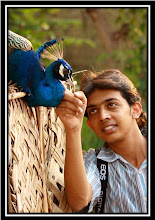Indian giant squirrel
The Indian giant squirrel, or Malabar giant squirrel, (Ratufa indica) is a large tree squirrel species genus Ratufa native to India. It is a large-bodied diurnal, arboreal, and herbivorous squirrel found in South Asia.
Description
The Ratufa indica has a conspicuous two-toned (and sometimes three-toned) color scheme. The colors involved can be creamy-beige, buff,tan, rust, brown, or even a dark seal brown. The underparts and the front legs are usually cream colored, the head can be brown or beige, however there is a distinctive white spot between the ears. Adult head and body length varies between 14 inches (36 cm) and the tail length is approximately 2 ft (0.61 m). Adult weight - 2 kg (4.41 lb).
Behavior
The Indian giant squirrel is an upper-canopy dwelling species, which rarely leaves the trees, and requires "tall profusely branched trees for the construction of nests." It travels from tree to tree with jumps of up to 6 m (20 ft). When in danger, the Ratufa indica often freezes or flattens itself against the tree trunk, instead of fleeing.[4] Its main predators are the birds of prey and the leopard.[4] The Giant Squirrel is mostly active in the early hours of the morning and in the evening, resting in the midday. It is a shy, wary animal and not easy to discover.
The species is endemic to deciduous, mixed deciduous, and moist evergreen forests of peninsular India,
It occupies isolated ranges that are widely separated from each other, thus producing conditions favorable for speciation. The squirrels found within each of these isolated ranges share distinctive color schemes, making it easy to identify which region a particular squirrel is from, as well as leading to the controversy as to whether these different color schemed subspecies ought to be considered as unique species



No comments:
Post a Comment